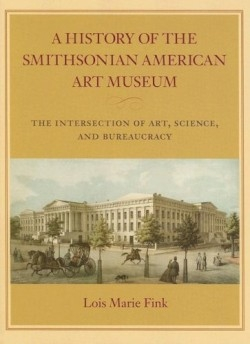A History of the Smithsonian American Art Museum
The Intersection of Art, Science, and Bureaucracy
“Within a year after the nation’s political center had moved to Washington.” begins History of the Smithsonian, “when roads were still little more than paths through the trees, government buildings stood half-built, private housing was grossly inadequate, and no established water or sewage system existed—one resident declared that what the city really needed was a museum.” Lois Marie Fink is research curator emerita of the Smithsonian American Art Museum and author of American Art at the Nineteenth-Century Paris Salons. A scholar and a twenty-three-year veteran of the Smithsonian, Fink ably pulls from the mundane details of her primary sources—memos, reports, plans—a robust narrative. Organized around major historical developments in the museum, each chapter provides an account of the vertiginous developments in what would eventually become, after more than a century, the Smithsonian American Art Museum. The narrative starts with private and governmental holdings from which the collection was originally derived, and a half a million dollar bequest from an Englishman who’d never seen America, John Smithson, in 1938. Then through fire, building changes, congressional wrangling, a legal case to establish one of several names for the museum, further bequests and behind-the-door manipulations, more name changes, turnovers in bureaucrats, and a backdrop of major transformations and upheavals in the cultural landscape, the narrative arrives at something of a triumph: “At last, the anticipation of many years became a reality. Emerging from unexpected turns and reversals of a meandering journey that had started before the founding of the Smithsonian, works of the nation’s oldest art collection began their new life with a celebration in the courtyard of the Patent Office Building.” General readers may find the book dense. Fink’s sometime laborious accretion of detail (for instance, a paragraph of twelve lines listing members of the 1938 Smithsonian Gallery of Art Commission, which was to oversee a design competition for a new building), and occasional favoring of rhetorical adornment over clarity, will find a better reception among museum scholars, professionals, and enthusiasts. But for the most part, Fink is adroit at finessing coherence, and even intrigue, out of loads of facts and details. By contextualizing the museum’s development, exploring its struggles with key questions about the function of museums, what art is, and what a national identity vis-à-vis art looks like, the book is an important addition to literature on art history and museum studies.
Reviewed by
Aimee Houser
Disclosure: This article is not an endorsement, but a review. The publisher of this book provided free copies of the book to have their book reviewed by a professional reviewer. No fee was paid by the publisher for this review. Foreword Reviews only recommends books that we love. Foreword Magazine, Inc. is disclosing this in accordance with the Federal Trade Commission’s 16 CFR, Part 255.

